
by Joseph Hull
[Director of Communications, Dolby Laboratories, San Francisco, California, USA]
The Dolby B-type noise-reduction system was introduced to the consumer in 1968; the first cassette decks incorporating it were introduced in 1970. Today, tens of millions of consumer audio products with Dolby noise reduction have been manufactured, and cassette recordings made with the system probably number in the hundreds of millions.
The adoption by the consumer electronics industry of a single noise-reduction system, with characteristics maintained throughout the world by means of a comprehensive licensing program, has ensured compatibility among recordings and recorders. Thus, any recording made with Dolby B-type noise reduction can be played on any machine equipped with Dolby B circuitry, regardless of manufacturer or country of origin. The effectiveness of the system is such that today's high-performance cassette recorders, using good tape formulations, can record the vast majority of available program material without significant degradation.
However, over the past two years or so, there has been a growing desire for a system giving even more noise reduction than is provided by Dolby B. Audiophile disc releases with wide dynamic range, a continuing reduction in the cost of amplifier power, loudspeaker systems with increased accuracy and robustness, the use of equalizers in elaborate systems, and in some markets a serious interest in high-quality live recording on cassettes are all indications of a need for more noise reduction, at least at the higher end of the marketplace. While it remains to be seen just how deeply that need goes, it seemed appropriate in late 1980 for Dolby Laboratories to offer its licensees the option to use a new system, Dolby C-type noise reduction, to supplement the standard B-type system. Dolby C provides 20 dB of noise reduction above about 1 kHz compared with the Dolby B-type system's 10 dB of noise reduction above about 4 kHz. Dolby C-type noise reduction has been designed specifically to deal with the noise spectrum and other parameters particular to slow-speed consumer tape recording formats such as the standard compact cassette and the microcassette.
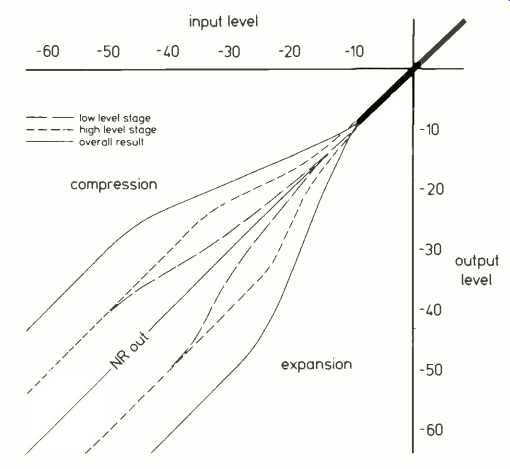
Fig. 1--Dolby C transfer characteristics, showing how the effects of
the two stages combine to produce 20 dB of compansion.
Objectives for Dolby C-Type Noise Reduction
The goal for a new Dolby system was not simply and arbitrarily "more noise reduction." A number of devices, such as wide-band companders, have long been available which provide more noise reduction than Dolby B under some signal conditions, most notably in the absence of signals altogether. However, these de vices also introduce such side effects as noise modulation and overshoot distortion under other signal conditions. Thus, an important objective for Dolby noise reduction was minimizing the side effects, and there were a number of other, related goals:
1. Quantity and quality of noise reduction. With a companding noise-reduction system, the greater the noise reduction desired, the more the signal must be manipulated by the encode/de code process, and thus the more likely that side effects will be audible. It was decided that Dolby C would not trade more noise reduction for more audible side effects than had Dolby B. This decision is not only reflected in the design of the system, but also in the choice of the amount of noise reduction the new system provides. To minimize the signal processing required, it was necessary to establish the minimum amount of noise reduction required to meet the likely demands of the market. It was concluded that for cassette recording, 20 dB of noise reduction would provide a noise level below that of any current or likely future program source, and would in deed result in tape noise below the ambient noise level of most home listening environments.
2. Tolerance of normal recorder errors. For a noise-reduction system to be practical, it must be reasonably tolerant of errors introduced by the recorder at both high and low frequencies between encoding and decoding. Dolby B-type noise reduction has proved sufficiently tolerant of such errors to be practical, so a similar tolerance was an objective for Dolby C. (As it turned out, Dolby C is more tolerant than Dolby B, as the result of developments which will be described later.)
3. Provision of the Dolby B characteristic. With so many Dolby B encoded recordings in use, it was thought essential to design the new system so that the Dolby B characteristic could be incorporated easily and economically. Licensees who decide to manufacture products with Dolby C-type noise reduction can provide Dolby B at the same time without the cost and complexity of redundant circuitry.
4. Cost. It was obvious that a system providing 20 dB of noise reduction would be more costly than Dolby B-type noise reduction. However, a considerable effort was made to keep its cost appropriate to at least the higher end of the current market. This meant the use of regularly available parts, and also a system which would not put a greater bur den on the manufacturer in the way of unusually elaborate production-line testing and adjustments.
5. The sound of Dolby C recordings played with Dolby B decoding. A vital factor in the adoption of Dolby B-type noise reduction has been that cassettes encoded with Dolby B sound acceptable on players not equipped with Dolby B circuitry. Thus, assuming there would be interest from duplicators in issuing C-type recordings, consideration was given in the design of the new system to what those recordings would sound like when played on machines equipped only with Dolby B-type or with no noise-reduction circuitry.
The Problem of Noise Modulation
With a companding noise-reduction system, noise reduction occurs at the moment of playback by means of an ex pander circuit which acts as a gain control constantly adjusting the playback volume. The general idea is to turn the volume down on quiet passages, thus turning down the noise as well, and to turn it back up again on loud passages, which will hopefully mask the noise. If this expanding process is preceded at the time the recording is made by a complementary compression process (i.e., turning the record level up on soft pas sages and down on loud ones), then the net result on playback should be a restoration of the dynamics of the original mu sic along with noise reduction.
In designing a system which minimizes audible side effects, the trick is to provide a subjectively consistent amount of noise reduction, that is, to design a system which does not allow the noise to audibly (and annoyingly) go up and down with level and/or spectral changes in the music. This problem is called noise modulation. As the expander turns up the volume on a loud bass drum rap, for example, it will also turn up the volume of the tape hiss at higher frequencies at the same time so that the bass drum note is accompanied by an audible burst of hiss.
In more than 15 years of research into noise reduction, Dolby Laboratories has discovered only two effective and practical ways to render noise modulation inaudible. The first of these techniques is called band-splitting, and it is used in professional Dolby A-type noise reduction, where the spectrum is divided into four bands, each of which has its own independent compander. Thus, when the hypothetical recording of the bass drum is played back, the expander which acts in the frequency range of the drum lets it through at full volume, while noise in the drum's vicinity is masked by its sound. But in the other bands, where no musical signals mask the noise, the other expanders simultaneously keep the volume turned down, thereby providing full noise reduction in regions such as that of tape hiss.
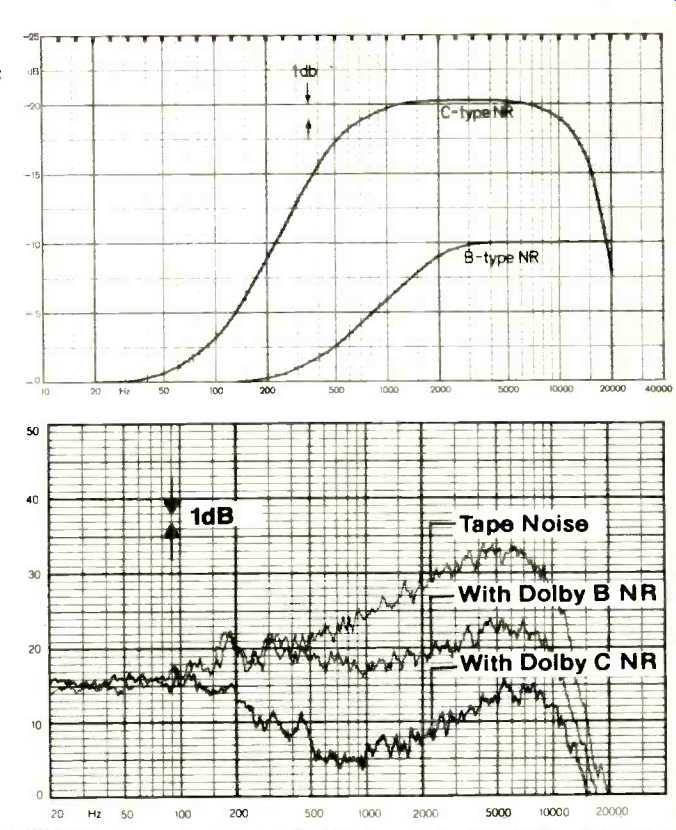
Fig. 2--Low-level encode characteristic of Dolby B and Dolby C (decoding
is precisely reciprocal).
Fig. 3--Noise from biased cassette tape (70 µS), measured with a constant-bandwidth wave analyzer and weighted (CCIR/ ARM) to reflect the ear's sensitivity to noise and noise-reduction effects.
The band-splitting technique is most appropriate to professional applications because it deals with noise at all audible frequencies; among other things, this characteristic complements the relatively equal distribution of noise in media such as higher-speed professional tape re cording. But it is a comparatively costly technique, which fortunately is not required for consumer tape recording where the predominant noise is higher frequency hiss. The second approach, called the sliding-band technique and developed for the Dolby B-type system, uses a single band of compansion which reaches low enough to provide effective noise reduction in the absence of signals, but which also changes its width in response to musical signals. In the case of the solo bass drum note, the companding band will slide up in frequency so that on playback the bass drum is let through at full volume, while the expander lowers the volume, and thus the tape hiss, at the frequencies above the bass drum where there is no musical signal. If the bass drum is accompanied by a violin, the companding band slides further up in frequency to let both the drum and violin through, while still maintaining noise reduction at frequencies above the violin. The result is an effective noise-reduction system with many of the same benefits as the band-splitting technique, but one which is more cost-effective and particularly appropriate to the needs of consumer tape recording. Thus, the sliding band technique has been used for the new C-type noise-reduction system.
Dual-Level Processing
Simply modifying Dolby B to provide 20 dB of compansion at higher frequencies instead of 10 dB is inadequate, as a single processing stage suffers from problems such as overshoots and level uncertainties in manufacturing. Those problems were overcome by the use of two compander circuits in a special way, by which both cover the same frequency band but are sensitive to signals at different levels. One processor is sensitive to signals at essentially the same level as the Dolby B-type processor, while the other is sensitive to signals at a some what lower level. Each processor provides 10 dB of compansion; as they are connected in series, their effects add together to-provide 20 dB of compansion and so 20 dB of noise reduction.
Figure 1 illustrates by means of transfer characteristic curves how the dual-level processors work together. Note that the total companding action is restricted to middle-level signals. At high signal levels, unlike conventional companders, there is no dynamic action and the system acts as a unity-gain amplifier, while at low signal levels, again unlike many conventional companders, the system acts only as a fixed-gain amplifier. By restricting the system's companding action, such side effects on the signal as overshoot distortion can be minimized; this is characteristic of all Dolby noise-reduction systems.
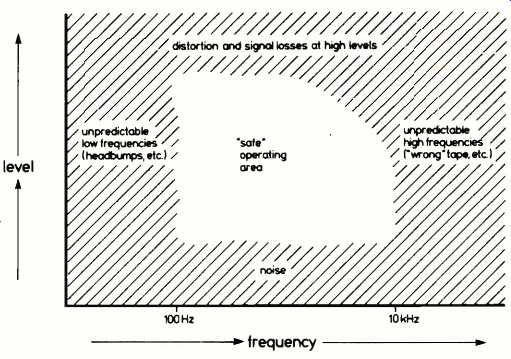
Fig. 4--To prevent mistracking between the compressor and the ex pander,
a noise-reduction system should operate only on signals which are reproduced
reliably by the medium. (The vagaries typical of cassette tape are illustrated.)
Noise-Reduction Bandwidth
Yet a further departure from Dolby B was required. The B-type system begins to take effect in the 300-Hz region and increases its action until a maximum of 10 dB of noise reduction is provided in the 4-kHz region and above. The subjective result, due to the ear's sensitivity to the particular spectrum of low-speed tape noise, is an overall reduction of noise, and the remaining noise is subjectively evenly distributed. However, reducing noise in the B-type system's operating range by a further 10 dB, while resulting in very noticeable additional hiss reduction, has the further subjective effect of revealing mid-frequency noise. Thus, a further difference between Dolby B and Dolby C is that the latter reaches two octaves lower, begins to take effect in the 100-Hz region, and provides on the order of 15 dB of noise reduction around 400 Hz and 20 dB in the critical 2 to 10 kHz hiss area. This means that Dolby C, like Dolby B, produces a subjectively even spectrum in what little noise remains (Figs. 2 and 3).
As can be seen in Fig. 2, the C-type system's action is sharply and deliberately curtailed below 100 Hz because of the ear's relative insensitivity to low level, low-frequency noise. The only potential low-frequency noise of any real concern is 50-Hz or 60-Hz hum, which can be kept inaudible (at all but totally impractical listening levels) by proper cassette recorder engineering. This is fortunate, because very low-frequency noise reduction brings up several new problems. For example, it might be tempting for a recorder designer to use the noise-reduction system as a crutch to reduce hum which could (and should) be eliminated by other means. Were there to be considerable hum and were a single-band (now virtually a wide-band) noise-reduction system to reach low enough to affect it, hum modulation would result, whereby higher frequency signals cause the hum level to go up and down audibly. The noise-reduction system could get around this problem if it included a separate low-frequency band, but then the cost and complexity of the system would go up substantially. In addition, a system providing noise reduction at very low frequencies would result in encoded recordings with substantially boosted low frequencies. Such recordings heard without reciprocal decoding would most likely be considered unacceptable due to gross exaggeration of such low-frequency noises in program sources as the room rumble inevitable at most recording sites and turntable rumble components from disc sources.
Dealing with Recorder/Tape Errors
It is important in noise-reduction systems that the expander precisely track the compressor so that the original signal is accurately reconstructed. In tape recording, however, the expander derives the information it needs to recon struct the original signal after the compressed signal has been recorded on the tape. Therefore, if the tape and recorder combination significantly alter the compressed signal, mistracking and potentially audible side effects can occur. To make things even more difficult, the degree to which recorder/tape errors are troublesome--is related to the amount of noise reduction desired. In cassette recording, the likelihood of the recorder and tape introducing unpredictable alterations of the signal is very real. For example, different recorders introduce different characteristic head "bumps" at low frequencies so that the signal level coming off any particular recorded tape at those frequencies cannot be predicted accurately.
While flat, extended response is theoretically achievable at high frequencies, above 10 kHz it is in reality also unpredictable because the consumer may use a type of tape for which his recorder is not adjusted, and/or the heads may be worn or dirty. Furthermore, he may use a record level too high for the tape, causing distortion and again unpredictable signal losses, particularly at higher frequencies. Ideally a noise-reduction system should operate only on signals in what might be termed a "safe" area, as shown in Fig. 4, where response from the tape can be predicted with some degree of certainty.
Dolby B-type and C-type noise reduction have been designed with these cassette limitations in mind. (For example, as shown earlier, neither system processes signals at unpredictable low frequencies.) But with C-type noise reduction, because more compression and expansion is being squeezed into the same safe operating area, two further developments were necessary to prevent such problems as mistracking, particularly at high frequencies. These are the blocks in Fig. 5 labeled "spectral skewing" and "anti-saturation."
1. Spectral skewing. To prevent ex pander errors as a result of unpredictable cassette response above 10 kHz (such as those caused by using the wrong tape type), a controlled high-frequency roll-off called spectral skewing is introduced ahead of the compressor when the system is in the encode mode.
This roll-off desensitizes the noise-reduction system so that it tends to ignore what's happening above about 10 kHz and so is less likely to mistrack as a re suit of changes in response introduced by the recording process. A complementary boost of frequencies above 10 kHz is introduced after the expander in the decode mode to maintain flat frequency response. While the noise-reduction effect is thus reduced above 10 kHz, the ear's sensitivity to noise above 10 kHz drops off at an even faster rate than does the noise-reduction effect.
2. Anti-saturation helps prevent over loading the tape at higher frequencies, not only to prevent signal losses which might cause expander mistracking, but also to provide higher quality recording overall by reducing the IM distortion resulting from saturation. A shelving network is placed in the circuit in such a way that it affects only the high-level signals which would cause saturation; at low levels, most of the signal passes through the low-level side chain, thus bypassing the network (and thereby maintaining the full noise reduction effect at low levels). As with spectral skewing, there is a complementary network in the decode (expansion) mode to maintain flat response.
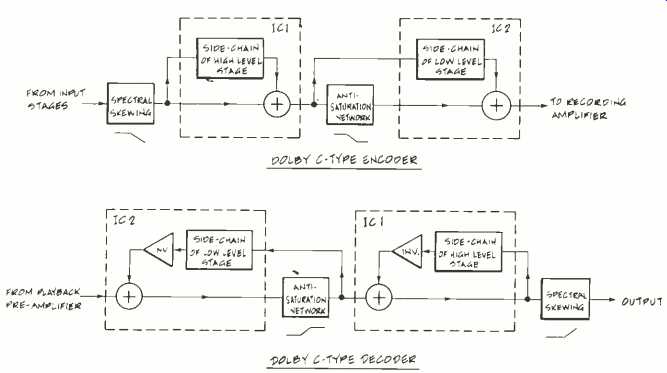
Fig. 5--Dolby C-type noise reduction block diagram.
The encode curves shown in Fig. 6 not only illustrate the overall characteristic of Dolby C-type noise reduction, but also show the specific effects of spectral skewing and anti-saturation. The roll-off above 10 kHz at all levels is the result of spectral skewing; the gentler downward slope beginning at about 1 .5 kHz on the higher-level curves is the result of anti-saturation.
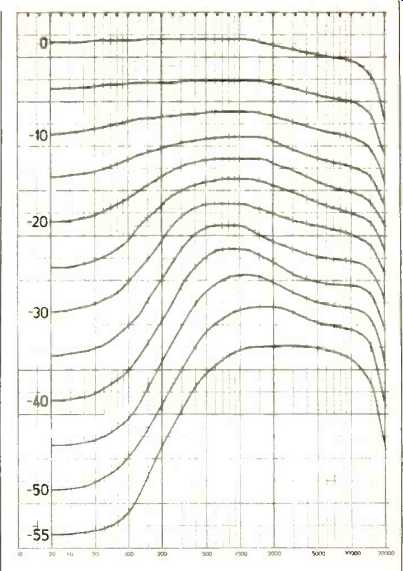
Fig. 6--Dolby C encode characteristics, showing the effects of spectral
skewing and anti-saturation (see text).
Implementation of the New System
Ultimately, the most efficient way for the cassette deck manufacturer to provide Dolby C-type noise reduction will be by means of dedicated C-type integrated circuits which are now being developed by several IC manufacturers. As this development will take some time, the first C-type circuits will be based on pairs of standard ICs now being manufactured for Dolby B in large-type noise reduction quantities and at moderate cost by seven different suppliers. Additional circuitry around the IC pairs provides the necessary changes in time constants, the anti saturation and skewing networks, switching between the B-type and C type characteristics, and so on. The complexity of the two-IC design is approximately 2.5 times that of Dolby B alone (however, the C-type circuit includes the B-type function as well). That figure should not be taken as a guide to what the premium will be at retail, be cause greater noise reduction puts greater demands on the recorder performance itself. (Input and output stage noise, for example, must be on the order of 10 dB lower than was necessary before.)
Dolby Laboratories provides its licensees with the C-type system's technology under terms of the current B-type licensing agreement. This means that the royalty paid Dolby Laboratories on a single Dolby noise-reduction processor will remain the same, whether it provides B type noise reduction only, C-type noise reduction only, or is switchable between both types. (The royalty per processor, which averaged 220 at the end of 1980, is not dependent on the number of ICs used.)
So far than 25 more manufacturers and marketers of consumer tape recorder products have plans to introduce models incorporating Dolby C-type noise reduction. Virtually all are likely to incorporate the switchable B-type feature so that existing libraries of Dolby B encoded cassettes will play back properly, and some will incorporate Dolby HX (headroom extension) circuitry in addition. Also, duplicators have several cassette expressed interest in releasing Dolby C encoded recordings, and prototype professional Dolby C encoders have been developed and are being tested for this purpose.
The first products incorporating Dolby C-type noise reduction have just begun to reach the market. It is not yet known how many consumers will elect to pay how much more for a cassette deck with a 10-dB lower noise floor than before. But those who choose these products are likely to find that, with Dolby C-type noise reduction, cassette tape noise, even at the highest playback levels, will no longer be a matter of practical concern.
== === === ==
(adapted from Audio magazine, May 1981)
Also see:
Dolby B-Type Noise Reduction System--part 1 (Sept. 1973)
Dolby B-Type Noise Reduction System--Part 2 (Oct. 1973)
Introducing Dolby S-Type Noise Reduction (Jun. 1990)
EQ & NR: Striking A Balance (Aug. 1988)
Deck to Deck Matching and NR: Straightening the Mirror (Aug. 1986)
A Dynamic Noise Filter for Mastering (June 1972)
National's New Noise Reduction Chip (Nov. 1981)
= = = =